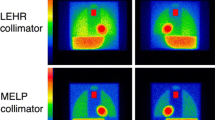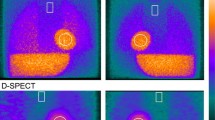Abstract
Background
Although the heart-to-mediastinum (H/M) ratio in a planar image has been used for practical quantification in 123I-metaiodobenzylguanidine (MIBG) imaging, standardization of the parameter is not yet established. We hypothesized that the value of the H/M ratio could be standardized to the various camera–collimator combinations.
Methods and results
Standard phantoms consisting of the heart and mediastinum were made. A low-energy high-resolution (LEHR) collimator and a medium-energy (ME) collimator were used. We examined multi-window correction methods with 123I- dual-window (IDW) acquisition, and planar images were obtained with IDW correction and the LEHR collimator. The images were obtained using the following gamma camera systems: GCA 9300A (Toshiba, Tokyo), E.CAM Signature (Toshiba/Siemens, Tokyo) and Varicam (GE, Tokyo). Cardiac phantom studies demonstrated that contamination of the H/M count ratio was greater with the LEHR collimator and least with the ME collimator. The corrected H/M ratio with the LEHR collimator was similar to that with ME collimators. The uncorrected H/M ratio with the ME collimator was linearly related to the H/M ratio with IDW correction with the LEHR collimator. The relationship between the uncorrected H/M ratios determined with the LEHR (E.CAM) and the ME collimators was y = 0.56x + 0.49, where y = H/M ratio with the E.CAM and x = H/M ratio with the ME collimator. The average normal values for the low-energy collimator (n=18) were 2.2±0.2 (initial H/M ratio) and 2.42±0.2 (delayed H/M ratio), and for the low/medium-energy (LME) collimator (n=14) were 2.63±0.25 (initial H/M ratio) and 2.87±0.19 (delayed H/M ratio). H/M ratios in previous clinical studies using LEHR collimators are comparable to those with ME collimators.
Conclusion
The IDW-corrected H/M ratios determined with the LEHR collimator were similar to those determined with the ME collimator. This finding could make it possible to standardize the H/M ratio in planar imaging among various collimators in the clinical setting.




Similar content being viewed by others
References
Tamaki N. Guidelines for clinical use of cardiac nuclear medicine (JSC 2005). Circ J 2005;69(suppl IV):1125–202.
Yamashina S, Yamazaki J. Neuronal imaging using SPECT. Eur J Nucl Med Mol Imaging 2007;34:939–50.
Yamashina S, Yamazaki J. Role of MIBG myocardial scintigraphy in the assessment of heart failure: the need to establish evidence. Eur J Nucl Med Mol Imaging 2004;31:1353–5.
Inoue Y, Suzuki A, Shirouzu I, Machida T, Yoshizawa Y, Akita F, et al. Effect of collimator choice on quantitative assessment of cardiac iodine 123 MIBG uptake. J Nucl Cardiol 2003;10:623–32.
Nakajima K, Matsubara K, Ishikawa T, Motomura N, Maeda R, Akhter N, et al. Correction of iodine-123-labeled meta-iodobenzylguanidine uptake with multi-window methods for standardization of the heart-to-mediastinum ratio. J Nucl Cardiol 2007;14:843–51.
Verberne HJ, Feenstra C, de Jong WM, Somsen GA, van Eck-Smit BL, Busemann Sokole E. Influence of collimator choice and simulated clinical conditions on 123I-MIBG heart/mediastinum ratios: a phantom study. Eur J Nucl Med Mol Imaging 2005;32:1100–7.
Yamazaki J, Muto H, Kabano T, Yamashina S, Nanjo S, Inoue A. Evaluation of beta-blocker therapy in patients with dilated cardiomyopathy – clinical meaning of iodine 123-metaiodobenzylguanidine myocardial single-photon emission computed tomography. Am Heart J 2001;141:645–52.
Morozumi T, Kusuoka H, Fukuchi K, Tani A, Uehara T, Matsuda S, et al. Myocardial iodine-123-metaiodobenzylguanidine images and autonomic nerve activity in normal subjects. J Nucl Med 1997;38:49–52.
Hattori N, Tamaki N, Hayashi T, Masuda I, Kudoh T, Tateno M, et al. Regional abnormality of iodine-123-MIBG in diabetic hearts. J Nucl Med 1996;37:1985–90.
Nakata T, Wakabayashi T, Kyuma M, Takahashi T, Tsuchihashi K, Shimamoto K. Cardiac metaiodobenzylguanidine activity can predict the long-term efficacy of angiotensin-converting enzyme inhibitors and/or beta-adrenoceptor blockers in patients with heart failure. Eur J Nucl Med Mol Imaging 2005;32:186–94.
Sakata K, Iida K, Kudo M, Yoshida H, Doi O. Prognostic value of I-123 metaiodobenzylguanidine imaging in vasospastic angina without significant coronary stenosis. Circ J 2005;69:171–6.
Nishimura T, Sugishita Y, Sasaki Y. The results of questionnaire on quantitative assessment of 123I-metaiodobenzylguanidine myocardial scintigraphy in heart failure. Kaku Igaku 1997;34:1139–48.
Matsuo S, Nakamura Y, Matsui T, Matsumoto T, Kinoshita M. Detection of denervated but viable myocardium in cardiac sarcoidosis with I-123 MIBG and Tl-201 SPECT imaging. Ann Nucl Med 2001;15:373–5.
Matsuo S, Nakamura Y, Matsumoto T, Takahashi M, Kinoshita M. Detection of coronary microvascular disease by means of cardiac scintigraphy. Can J Cardiol 2002;18:183–6.
Matsuo S, Nakamura Y, Tsutamoto T, Kinoshita M. Impairments of myocardial sympathetic activity may reflect the progression of myocardial damage or dysfunction in hypertrophic cardiomyopathy. J Nucl Cardiol 2002;9:407–12.
Matsuo S, Nakae I, Takada M, Murata K, Nakamura Y. Noninvasive identification of myocardial sympathetic and metabolic abnormalities in a patient with restrictive cardiomyopathy in comparison with perfusion imaging. Ann Nucl Med 2002;16:569–72.
Imamura Y, Fukuyama T, Mochizuki T, Miyagawa M, Watanabe K; Ehime MIBG Heart Failure Study Investigators. Prognostic value of iodine-123-metaiodobenzylguanidine imaging and cardiac natriuretic peptide levels in patients with left ventricular dysfunction resulting from cardiomyopathy. Jpn Circ J 2001;65:155–60.
Matsuo S, Nakamura Y, Matsumoto T, Nakae I, Takada M, Murata K, et al. Prognostic value of Iodine-123 metaiodobenzylguanidine imaging in patients with heart failure. Exp Clin Cardiol 2003;8:95–8.
Matsuo S, Takahashi M, Nakamura Y, Kinoshita M. Evaluation of cardiac sympathetic innervation with iodine-123-metaiodobenzylguanidine imaging in patients with silent myocardial ischemia. J Nucl Med 1996;37:712–7.
Matsuo S, Nakamura Y, Takahashi M, Matsui T, Kusukawa J, Yoshida S, et al. Cardiac sympathetic dysfunction in athlete’s heart detected by 123I MIBG scintigraphy. Jpn Circ J 2001;65:371–4.
Kobayashi H, Momose M, Kanaya S, Kondo C, Kusakabe K, Mitsuhashi N. Scatter correction by two-window method standardizes cardiac I-123 MIBG uptake in various gamma camera systems. Ann Nucl Med 2003;17:309–13.
Nagamatsu H, Momose M, Kobayashi H, Kusakabe K, Kasanuki H. Prognostic value of 123I-metaiodobenzylguanidine in patients with various heart diseases. Ann Nucl Med 2007;21:513–20.
Nakajima K, Kumita S, Ishida Y, Momose M, Hashimoto J, Morita K, et al. Creation and characterization of Japanese standards for myocardial perfusion SPECT: database from the Japanese Society of Nuclear Medicine working group. Ann Nucl Med 2007;21:505–11.
Motomura N, Ichihara T, Takayama T, Aoki S, Kubo H, Takeda K. Practical compensation method of downscattered component due to high energy photon in 123I imaging. Kaku Igaku 1999;36:997–1005.
Kasama S, Toyama T, Kumakura H, Takayama Y, Ichikawa S, Suzuki T, et al. Spironolactone improves cardiac sympathetic nerve activity and symptoms in patients with congestive heart failure. J Nucl Med 2002;43:1279–85.
Bai J, Hashimoto J, Ogawa K, Nakahara T, Suzuki T, Kubo A. Scatter correction based on an artificial neural network for 99mTc and 123I dual-isotope SPECT in myocardial and brain imaging. Ann Nucl Med 2007;21:25–32.
Acknowledgments
We wish to thank the many physicians and technologists who contributed to the accumulation and generation of the database. We also thank the staff of the Department of Nuclear Medicine at Kanazawa University Hospital for technical assistance. We also thank Drs. Junichi Yamazaki and Shohei Yamashina of Toho University Hospital, and Kazuyuki Sakata of the Shizuoka Cancer Center for supplying clinical data. This work was supported partly by Grants-in-Aid for Scientific Research in Japan (No. 19591403).
Author information
Authors and Affiliations
Corresponding author
Additional information
An editorial commentary on this paper is available at http://dx.doi.org/10.1007/s00259-008-0976-x
Rights and permissions
About this article
Cite this article
Matsuo, S., Nakajima, K., Okuda, K. et al. Standardization of the heart-to-mediastinum ratio of 123I-labelled-metaiodobenzylguanidine uptake using the dual energy window method: feasibility of correction with different camera–collimator combinations. Eur J Nucl Med Mol Imaging 36, 560–566 (2009). https://doi.org/10.1007/s00259-008-0971-2
Received:
Accepted:
Published:
Issue Date:
DOI: https://doi.org/10.1007/s00259-008-0971-2




